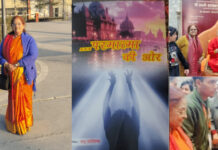Children’s literature holds a special place in the world of storytelling, nurturing imagination, fostering emotions, and imparting valuable life lessons in the most enchanting ways. Author Vinita Singh Shetty has embraced this art with her latest book, Reyah and the Cosmic Wish – A Magical Journey of Hope, Love & the Power of Dreams.
In this insightful conversation, Vinita discusses what inspired her storytelling, the core values she hopes to instill in young readers, and the creative process behind bringing her characters to life. She delves into the magic of illustrations, the balance between entertainment and education, and the important role books play in fostering a child’s love for reading in a digital age. Join us as we explore the heart of her writing journey and discover how her stories continue to inspire wonder, curiosity, and kindness in children everywhere!
- What inspired you to write for a younger audience, and how do you approach crafting a story that resonates with children? As a journalist, I’ve always been fascinated by the power of stories and their ability to stir emotions and bring people together. But when it comes to children, they see the world through eyes full of wonder and trust. Writing for kids means capturing that simple, beautiful perspective of life. I aim to create stories that feel real and warm, never treating kids like little adults. They have an incredible intuition, and I want to tap into that by exploring themes like friendship, curiosity, and the kind of wonder that makes the world feel new.
- Children’s books often carry important messages. Can you tell us about the themes or values you aimed to convey in your latest book? In my latest book, kindness takes center stage—demonstrating how even the smallest acts can make a big difference. Children naturally trust others, and I think that’s truly special. They show us how an open heart can change everything. I want young readers to know that even when the world seems tough, their kindness has the power to light up dark places. This message comes from my desire to preserve the purity of a child’s heart, where goodness and trust come so naturally.
- Illustrations play a crucial role in children’s books. How did the collaboration with the illustrator enhance the storytelling, and what was the creative process like? Oh, the illustrations are the heart of the story! They bring my words to life in ways I could never do alone. I have a clear vision when I write, but it’s the illustrator who adds the magic—almost like sprinkling stardust. We worked closely to ensure the pictures reflected the emotions of the story. For instance, if a character feels nervous, soft, warm colors help convey that feeling. The creative process was a fun collaboration—we exchanged ideas and watched the story come to life in wonderful ways!
- Connecting with young readers is essential. How do you strike a balance between entertaining and educating in your children’s books? Children are natural learners, absorbing so much without even realizing it. I believe stories can both entertain and teach without having to choose between the two. For example, instead of giving a lesson on empathy, I’ll show a character practicing kindness. I weave lessons into the story naturally, making learning part of the adventure. The best way to teach kids is through stories that are so fun, they don’t even realize they’re learning!
- Your characters are charming and relatable. How do you create characters that children can identify with, and do they draw from your own childhood experiences? I believe children connect with characters who feel real, even if they’re on an extraordinary journey. I create characters who are brave but imperfect and full of potential. I often draw from my own childhood experiences—the excitement of trying something new, the joy of discovering something for the first time, and the frustration of feeling misunderstood. These are emotions kids experience, and I want them to see themselves in my characters. These small, real moments make kids feel seen, heard, and understood.
- In the digital age, children have various forms of entertainment. How do you see the role of children’s books in fostering a love for reading and storytelling? In today’s world, it’s easy for kids to get lost in digital noise. But books offer something different. They invite children into a world where their imaginations can run wild. When kids read, they build entire worlds in their minds and experience the magic of a story. Reading helps them explore emotions, understand others, and view the world from different perspectives. With the right story, kids won’t just put the book down—they’ll want to come back to it over and over.
- The language and writing style in children’s books are distinct. How do you tailor your writing to engage young readers while maintaining a level of sophistication that can grow with them? Writing for children means keeping it simple, yet leaving room for their imaginations to grow. I don’t talk down to kids. Instead, I write in a way that feels fun and inviting. I use rhythm, repetition, and playful language to keep the story moving, while also introducing new words and ideas that stretch their minds. The beauty of writing for children is that these stories evolve with them. As they grow, they can return to the story and discover new layers and deeper meanings.
- Family and educators often play a role in introducing children to books. How do you envision your books being used in educational settings or as part of family reading routines? I see my books as a way to spark meaningful conversations, whether in the classroom or at home. For teachers, I hope these stories help bring lessons about empathy, kindness, and friendship to life. For families, I want my books to create special moments shared together—like parents reading aloud to their children before bed or teachers leading class discussions. These shared moments of storytelling help build connections that last a lifetime.
At the end of the day, children are at the heart of storytelling. Their openness and ability to embrace the world with curiosity and wonder are things we can all learn from. Writing for them is more than just a job—it’s an honor. I can’t wait to share these stories with the world.
Get your copy now on Amazon and dive into this magical tale, discovering the power of believing in your dreams!


















